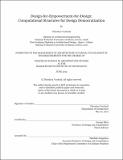| dc.contributor.advisor | George Stiny. | en_US |
| dc.contributor.author | Vardouli, Theodora | en_US |
| dc.contributor.other | Massachusetts Institute of Technology. Dept. of Architecture. | en_US |
| dc.date.accessioned | 2012-09-13T18:57:37Z | |
| dc.date.available | 2012-09-13T18:57:37Z | |
| dc.date.issued | 2012 | en_US |
| dc.identifier.uri | http://hdl.handle.net/1721.1/72864 | |
| dc.description | Thesis (S.M. in Architecture Studies)--Massachusetts Institute of Technology, Dept. of Architecture, June 2012. | en_US |
| dc.description | "June 2012." Cataloged from PDF version of thesis. | en_US |
| dc.description | Includes bibliographical references (p. 107-112). | en_US |
| dc.description.abstract | The vision to engage non-architects in the design of their habitat through the mediation of computer aids, dates back to the early computational era (1960s-1970s) and is currently being recast under cyber-cultural and technological influences. The computational tools enabling this architectural do-it-yourself-ism have been traditionally conceptualized as mediating "infrastructures:" neutral and non-defining control systems, which ensure the validity of the designs produced by the non-expert users without distorting their personal hypotheses. Through a critical comparative analysis of two basal computational systems for design "democratization," as discussed in Yona Friedman's and Nicholas Negroponte's early 1970s writings, this thesis illustrates that the "infrastructure" metaphor was engendered and still resides in a positivist paradigm of design, allowing for little freedom or intuition on behalf of the user. Rather than denouncing the internal contradictions of the "structure for freedom" model, this thesis inquires into the computational structures of Friedman's and Negroponte's proto-computational proposals in order to identify and critique the assumptions which underpin their optimism about the non-paternalistic character of their control systems. By exposing the discursive role of the internal workings of the two systems in their authors' arguments, along with their cultural and historical biases, this research aims to problematize inherited approaches to computational tools for user empowerment in design which persist until the present, and to hint to new programmatic agendas. | en_US |
| dc.description.statementofresponsibility | by Theodora Vardouli. | en_US |
| dc.format.extent | 139 p. | en_US |
| dc.language.iso | eng | en_US |
| dc.publisher | Massachusetts Institute of Technology | en_US |
| dc.rights | M.I.T. theses are protected by
copyright. They may be viewed from this source for any purpose, but
reproduction or distribution in any format is prohibited without written
permission. See provided URL for inquiries about permission. | en_US |
| dc.rights.uri | http://dspace.mit.edu/handle/1721.1/7582 | en_US |
| dc.subject | Architecture. | en_US |
| dc.title | Design-for-empowerment-for-design : computational structures for design democratization | en_US |
| dc.title.alternative | Computational structures for design democratization | en_US |
| dc.type | Thesis | en_US |
| dc.description.degree | S.M.in Architecture Studies | en_US |
| dc.contributor.department | Massachusetts Institute of Technology. Department of Architecture | |
| dc.identifier.oclc | 808368077 | en_US |
